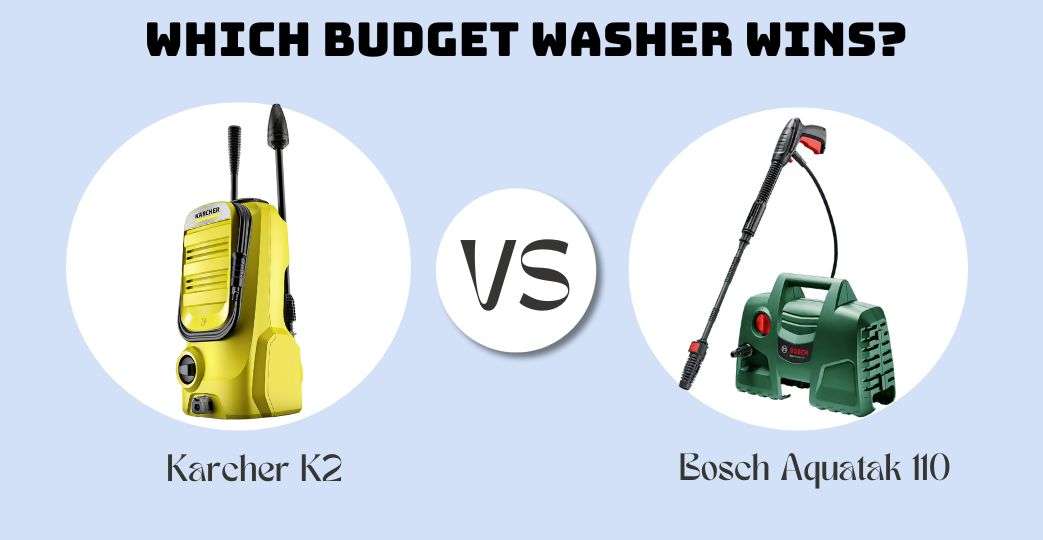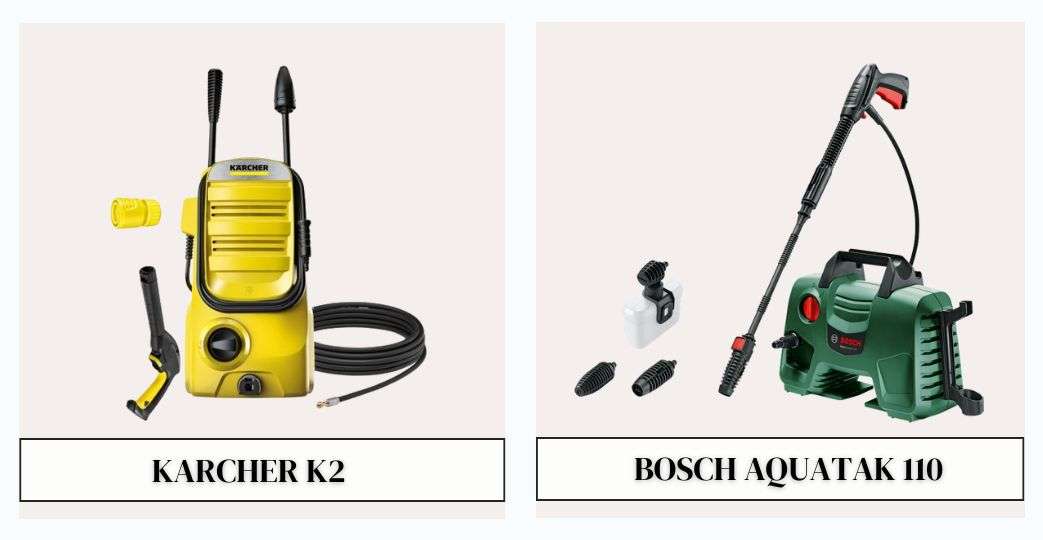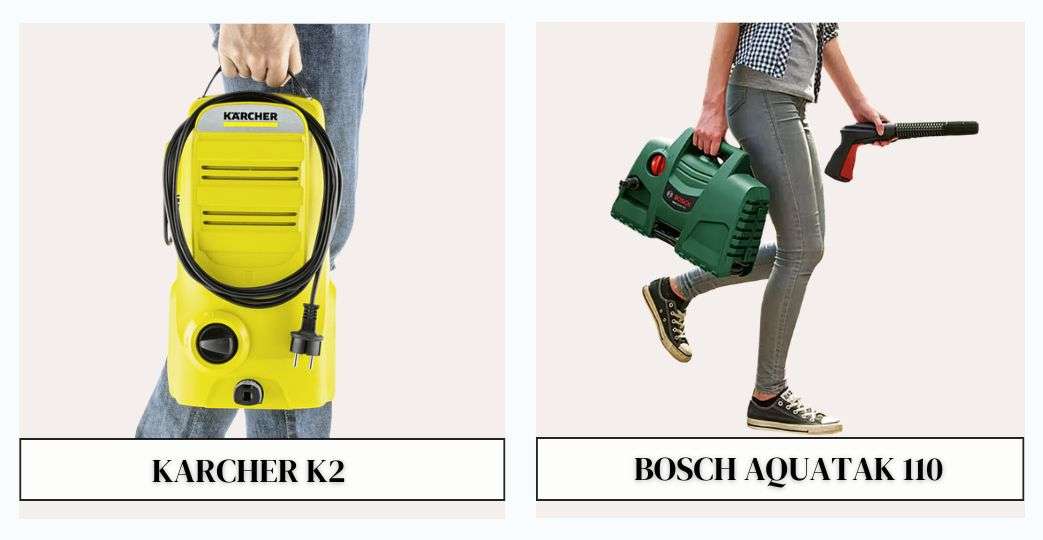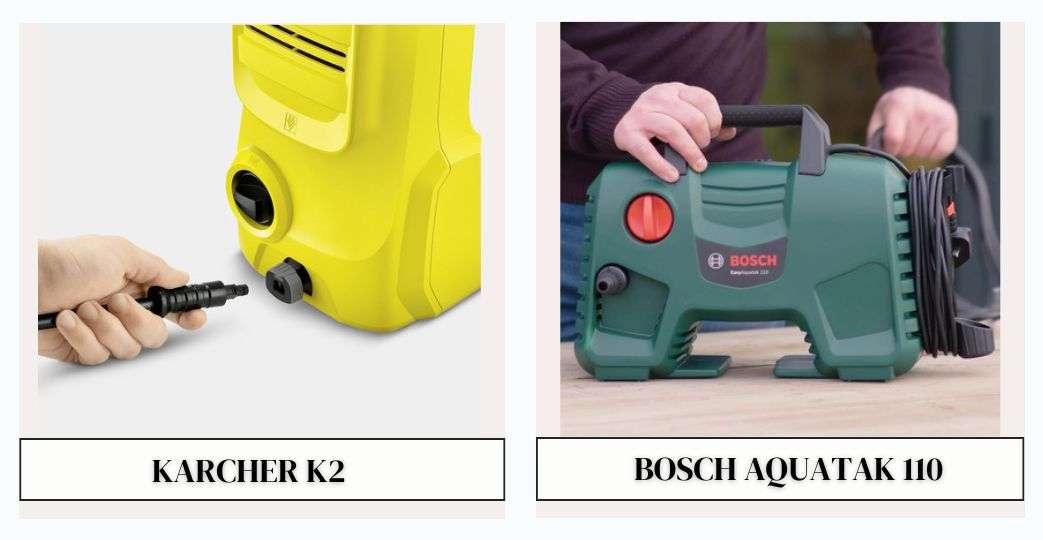Karcher K2 vs Bosch Aquatak 110: Which Budget Washer Wins?

June 13th 2025
Budget-friendly pressure washers have become essential for keeping things spotless, particularly in unique challenges like relentless dust and heat at construction sites. They’re also gaining popularity among DIY enthusiasts. The Karcher K2 and the Bosch Aquatak 110 are the two names that stand out. We're comparing the Karcher K2 vs Bosch Aquatak 110 to see which budget washer wins.
The Head-to-Head: Karcher K2 vs Bosch Aquatak 110
We've chosen these ten parameters because they directly impact the performance, usability, durability, and overall value you get from a pressure washer.
1. Pressure and Flow Rate
Pressure (measured in Bar or psi) indicates the force with which the water impacts the surface. Flow rate (measured in litres per Hour or Gallons per Minute) tells you how much water the machine delivers. Together, these numbers determine the cleaning power. Higher pressure helps lift stubborn dirt, while a higher flow rate helps wash it away quickly.
Karcher K2
It typically offers around 110 Bar (1600 PSI) pressure and a flow rate of about 360 litres per Hour, which is standard for light-duty machines. This gives you enough pressure to tackle dirt and grime on patios, cars, and garden furniture, and the flow rate is sufficient for effectively rinsing these areas.
Bosch Aquatak 110
Also delivers approximately 110 Bar (1600 PSI) pressure. However, its flow rate is often slightly lower, around 330 litres per Hour. The pressure rating is identical, meaning the force of the water hitting the surface is similar. The lower flow rate means you might take a bit longer to rinse large areas compared to the Karcher K2, assuming everything else is equal.
Key Takeaway
On paper, the pressure is identical, which is the primary force that breaks down dirt. The slight difference in flow rate is negligible for the typical tasks these machines handle. Both offer adequate power for budget-level cleaning. It's a very close match on this fundamental metric.
2. Motor Power
The wattage of the motor indicates how much power the machine consumes and, generally, the capability of the pump it drives. A more powerful motor can sustain pressure better and potentially handle slightly longer operating times.
Karcher K2
Generally equipped with a motor of around 1400 Watts. This is sufficient to generate and maintain the 110 Bar pressure and 360 L/h flow rate for typical short cleaning bursts.
Bosch Aquatak 110
Also typically features a motor rated at 1400 Watts. Like the Karcher, this motor size powers the pump effectively for the stated specifications (110 Bar, 330 L/h).
Key Takeaway
Both machines use motors of similar size. This suggests they have comparable power plants driving the pump. You don't see a significant advantage for either here in terms of raw motor power specification. The efficiency and durability of the motor and pump unit become more relevant, which relates to build quality.
3. Design and Build Quality

How the machine is constructed, the materials used, and its overall sturdiness. This is crucial for longevity, especially in demanding environments or with frequent use. For you, working in potentially dusty, hot conditions, a robust build means the tool lasts longer and withstands tougher handling.
Karcher K2
Karcher K2 units are often designed to be lightweight and compact. They feature plastic housings, which feel sturdy enough for home use but might feel less substantial compared to higher-end machines.
While generally reliable for their intended purpose, some users report components feeling less robust over time, particularly plastic connectors. Karcher prioritises lightweight design for easy handling.
Bosch Aquatak 110
Bosch pressure washers, including the Aquatak 110, tend to feel more solid and well-built. Bosch leverages their experience in power tool construction, often resulting in more rigid plastics and more durable internal components.
The overall feel is one of greater robustness. You pick it up, and it feels like a proper tool designed to take a bit more of a beating. This build quality is a significant factor for professionals and serious DIYers.
Key Takeaway
This is where we start seeing a potential difference relevant to our audience. While both use plastic, the quality and thickness of the plastic and the internal component design often give the Bosch Aquatak 110 a perceived edge in durability and build quality. For tools used in potentially dusty environments or transported frequently, this extra robustness from Bosch is a definite plus.
4. Hose Length and Quality
The length of the high-pressure hose determines how far you can reach the machine without moving the unit itself. The quality affects flexibility, durability, and resistance to kinking.
Karcher K2
Typically comes with a 3-meter high-pressure hose. This is relatively short. It means you need to position the unit very close to your cleaning area and move it frequently when cleaning larger items like a car or a patio. The hose material is usually standard plastic, which can be prone to kinking.
Bosch Aquatak 110
Usually includes a 3-meter high-pressure hose, similar to the Karcher K2. Some specific bundles might offer slightly longer hoses, but 3 meters is standard for the basic 110 model. The hose quality is generally comparable to the Karcher K2 at this price point – functional but not high-end.
Key Takeaway
This is another parameter where both basic models fall short with only a 3-meter hose. For professional or even serious DIY work, a longer hose (5m or more) significantly improves workflow. Neither unit has a clear advantage here in its standard configuration. You'll likely wish for a longer hose regardless of which you choose.
5. Cable Length
The length of the electrical power cable. A longer cable provides more flexibility in positioning the unit relative to the power source, reducing the need for extension cords, especially outdoors.
Karcher K2
It typically comes with a power cable that is around 5 meters long. This is a decent length for reaching outdoor power outlets or outlets in a garage.
Bosch Aquatak 110
It also usually features a power cable around 5 meters long. This matches the reach offered by the Karcher K2.
Key Takeaway
Both machines offer a standard 5-meter power cable. This is adequate for most situations, but combined with the short high-pressure hose, you'll still need to think about positioning the unit and power source carefully. No winner here; they are equally matched.
6. Weight and Portability

The weight of the unit and how easy it is to carry and move around. For you, this matters if you need to have it between different cleaning spots on a property, lift it in and out of a vehicle, or store it away easily.
Karcher K2
Designed to be very lightweight, often weighing around 4-5 kg. It typically features a carry handle at the top, making it easy to lift and move. Its compact size also aids portability and storage.
Bosch Aquatak 110
It is also designed for portability but might be slightly heavier than the Karcher K2, often in the 5-6 kg range. It also includes a robust carry handle. Bosch sometimes integrates wheels or a trolley system on slightly higher models. Still, the basic 110 is primarily a lift-and-carry unit.
Key Takeaway
The Karcher K2 has a slight edge in being marginally lighter, which could be a factor if you need to carry it long distances or up and down stairs frequently. However, the Bosch Aquatak 110 is still very portable. The difference of 1-2 kg is minimal for most users. It might be a trade-off for potentially more durable internal components in the Bosch. Both are easy to store due to their compact size.
7. Included Accessories
The machine comes with different nozzles, lances, detergent applicators, and other attachments. These add versatility and allow you to tackle various cleaning tasks effectively.
Karcher K2
Typically includes a standard trigger gun, a spray lance with adjustable pressure (or two separate lances for different pressures/tasks), and sometimes a dirt blaster nozzle (a powerful rotating jet for stubborn spots). Some K2 bundles also include a small detergent suction hose or bottle. The accessories are functional and cover basic needs.
Bosch Aquatak 110
Comes with a Bosch high-pressure gun, a lance, and notably, a "Fan Jet Nozzle" and a "Rotary Nozzle." The Fan Jet is for general cleaning, and the Rotary Nozzle provides a powerful, concentrated stream similar to Karcher's dirt blaster.
A significant inclusion is the Bosch High-Pressure Detergent System. This attaches directly to the lance, applying detergent effectively at low pressure before you switch back to high pressure for rinsing. This integrated detergent system is often more convenient and effective than Karcher's basic suction tube on K2 models.
Key Takeaway
Both provide essential nozzles for general cleaning and tackling tougher dirt. However, the Bosch Aquatak 110's integrated High-Pressure Detergent System is a valuable addition. This makes applying detergent much easier and more efficient than Karcher's basic suction method on K2. For tasks involving soap (like washing vehicles), the Bosch offers a noticeable advantage in usability.
8. Noise Level
How loud is the machine when operating? Pressure washers are inherently noisy, but some are less bothersome than others. For you, potentially working near others or for extended periods, lower noise is a benefit.
Karcher K2
Pressure washers are loud machines, and the K2 is no exception. You can expect noise levels to be typically around 90 dB or slightly higher when in use. This requires ear protection during operation.
Bosch Aquatak 110
The Bosch Aquatak 110 operates at a similar noise level to the Karcher K2, generally in the 90 dB range. The noise comes from the pump and motor working under high pressure. Again, ear protection is essential when you operate this machine.
Key Takeaway
There is no significant difference in noise output between these two budget models. Both are loud tools, and you should always use appropriate hearing protection when operating them. Don't expect a quiet cleaning experience with either.
9. Ease of Use and Setup

How quickly and easily you can connect everything, start the machine, and begin cleaning. This includes hose connections, power hookups, and attaching lances/nozzles. Time is money, so quick setup matters.
Karcher K2
Karcher uses a push-fit system for hose and lance connections on many models (Quick Connect). This generally makes setup and changing accessories quick and straightforward. Connecting the water supply and power cable is standard for any pressure washer.
Bosch Aquatak 110
Bosch utilizes its own SDS quick-connect fittings for hoses and lances. This system is equally fast and straightforward to use as Karcher's Quick Connect. Attaching the hose, power, and lance is intuitive. The integrated accessory storage on the unit also makes it easy to keep everything together.
Key Takeaway
Both brands have designed their entry-level units for ease of use. The quick-connect systems are efficient on both the Karcher K2 and the Bosch Aquatak 110. Setting up and starting either machine takes minimal time. Bosch's integrated storage for accessories adds a slight convenience factor for keeping everything tidy between uses.
10. Price and Value for Money
The initial purchase price and what you get for your money in terms of performance, features, durability, and accessories. For a budget category, this is often a deciding factor.
Karcher K2
The Karcher K2 is often positioned as slightly more affordable than the Bosch Aquatak 110, particularly in its most basic configurations. It offers standard budget pressure washer performance and accessories for the price. Its value comes from being a very accessible entry point into pressure washing.
Bosch Aquatak 110
The Bosch Aquatak 110 might have a slightly higher price tag than the most basic Karcher K2 models. However, it often includes a superior integrated detergent system. It may be more robust in terms of build quality for this slightly higher investment.
Key Takeaway
This is where "value" becomes subjective based on your priorities. If the absolute lowest price is your only concern, the Karcher K2 might win depending on current promotions.
However, if you factor in potential durability, the more convenient detergent system, and the overall feel of a more robust tool designed by a company known for power tools, the Bosch Aquatak 110 often presents a stronger value proposition for the target audience who prioritize performance and longevity beyond just the lowest sticker price. You pay a little more, but you often get features and build quality that justify it.
Comparison Table: Karcher K2 vs Bosch Aquatak 110
Let's put it all together in a quick table for easy comparison.
| Feature | Karcher K2 | Bosch Aquatak 110 | Notes for UAE Users |
| Pressure | ~110 Bar (~1600 PSI) | ~110 Bar (~1600 PSI) | Sufficient for common dust, dirt, and vehicle cleaning. Matched. |
| Flow Rate | ~360 L/h | ~330 L/h | Karcher is slightly higher, but the difference is minimal for this power class. |
| Motor Power | ~1400 Watts | ~1400 Watts | Comparable power output. |
| Design/Build | Lightweight plastic, feels less substantial | Sturdier plastic, feels more robust | Bosch feels better suited for handling/durability in tougher conditions. |
| Hose Length | 3 meters | 3 meters | Both hoses are short; require moving the unit frequently. |
| Cable Length | 5 meters | 5 meters | Adequate but standard. |
| Weight | ~4-5 kg | ~5-6 kg | Karcher is slightly lighter. Both are portable. |
| Accessories | Standard lances, maybe a detergent tube | Standard lances, Rotary/Fan Jet, Detergent System | Bosch's integrated detergent system is more convenient for cleaning vehicles/items needing soap. |
| Noise Level | ~90+ dB | ~90+ dB | Both are loud; require hearing protection. |
| Ease of Use/Setup | Quick Connect fittings, easy setup | SDS quick-connect, integrated storage, easy setup | Both are easy to set up. Bosch's storage is a minor plus. |
|
Price |
Often slightly lower entry price | Often slightly higher entry price | Karcher might be cheaper upfront; Bosch often offers more value for the slight premium. |
Verdict: It's Close, But nuances matter...
Looking at the table, it's clear that on the core performance metrics (pressure and motor power), the Karcher K2 and Bosch Aquatak 110 are very similar. They both offer adequate cleaning power for typical light to medium tasks you'd tackle around a home or small workshop. Their portability and ease of use are also comparable, with both featuring user-friendly connection systems.
For someone whose absolute top priority is the lowest possible purchase price and who only anticipates very light, infrequent use, the Karcher K2 is a competent machine. It gets the job done for basic cleaning, like washing a bike or small garden tools.
However, for our audience – those who approach tasks with a professional mindset, whether on a job site or tackling serious DIY projects – the picture changes slightly. This audience values durability, efficiency, and innovative design features that save time and effort.
When you weigh the Karcher K2 vs Bosch Aquatak 110, and you consider reliability, ease of use for everyday tasks like washing with soap, and the expectation of a durable tool, the Bosch Aquatak 110 emerges as the winner for our discerning audience in the UAE. You invest in a machine that feels like a quality tool, not just a basic appliance.
Frequently Asked Questions (FAQs)
Q. What tasks are budget pressure washers like these best suited for?
You should use these machines for light to medium-duty cleaning. This includes washing cars, motorcycles, bicycles, garden furniture, small patios, walkways, garden tools, and lightly soiled outdoor surfaces. They are great for removing dust, dirt, algae, and light mud.
Q. Can I use detergents with these pressure washers?
Yes, you absolutely can use compatible pressure washer detergents. The Bosch Aquatak 110 has a convenient integrated high-pressure detergent system, which makes application very easy. Always use detergents specifically designed for pressure washers and follow the manufacturer's instructions for both the detergent and the pressure washer.
Q. How long can I run a budget pressure washer continuously?
Budget pressure washers are designed for intermittent use, not continuous heavy-duty operation like professional models. Running them for extended periods (e.g., more than 15-20 minutes non-stop) can overheat the motor and pump, potentially causing damage. You should allow the machine to rest and cool down periodically during longer cleaning sessions. Check the user manual for specific guidelines.
Q. Why choose Bosch specifically for construction-related or tough DIY jobs?
Bosch has a strong legacy in manufacturing robust and reliable power tools for professional trades. This engineering expertise often translates into their other product lines, including pressure washers. You choose Bosch because you trust their motors, pumps, and overall build quality to stand up to more demanding use compared to brands solely focused on light home cleaning.
Final Words
While the Bosch Aquatak 110 is an excellent starting point and a strong budget contender, Bosch offers a full range of pressure washers with increasing levels of power, flow rate, and features.
If you find yourself needing to clean larger areas frequently, tackle tougher, caked-on mud or grime, or require a machine for more prolonged use, exploring Bosch's higher-numbered Aquatak models would be a smart next step.
We invite you to explore our extensive range of Bosch pressure washers and other essential tools and materials. You'll find the Bosch Aquatak 110 we discussed alongside more powerful options and all the accessories you need to keep your projects and property spotless.